Introduction to the Quasar Framework
In today’s fast-paced world of web and mobile app development, having a framework that can efficiently handle multiple platforms has become crucial. Enter the Quasar Framework. Built on Vue.js, Quasar is a nifty, open-source, cross-platform framework specifically designed to help developers create high-performance, responsive applications with ease.
What Exactly is the Quasar Framework?
Quasar is like a magic toolbox that extends the capabilities of Vue.js, enabling developers to craft applications that run flawlessly across various platforms, from web and mobile to desktops. The heart of Quasar’s philosophy can be summed up in its motto: “Write code once and deploy it everywhere.” With Quasar, you can develop single-page applications, progressive web apps (PWAs), server-side rendered apps, along with mobile apps for iOS and Android, and even desktop apps using Electron—all from a single codebase. Talk about ultimate convenience!
Awesome Features of Quasar
One of the major highlights of Quasar is its cross-platform support. Whether you’re building a web app, mobile app, or desktop app, Quasar has your back. It smartly leverages technologies like Cordova and Electron to ensure your application runs seamlessly across different environments.
Quasar doesn’t stop there. It boasts a comprehensive library of over 70 high-performance Material Design components. This means you can spend more time crafting unique features for your application instead of getting bogged down by repetitive boilerplate code.
Responsiveness is another key forte of Quasar. Designed with a robust grid system and layout elements, Quasar ensures your app looks great on any device. Be it a desktop, tablet, or smartphone, Quasar’s components adapt seamlessly.
Getting started with Quasar is a breeze. The Quasar CLI makes the setup process as smooth as butter. You can install the CLI globally on your machine, create a new project, and switch effortlessly between deployment targets depending on your needs.
Kicking Off with a Quasar Project
Starting a new Quasar project is simple and straightforward. First, you need to install the Quasar CLI, which can be done using npm or yarn:
npm install -g @quasar/cli
or
yarn global add @quasar/cli
Once the CLI is installed, creating a new project is as easy as pie:
quasar create <folder_name>
This command sets up a basic project structure by prompting you to answer a few questions about your project’s setup. Once done, navigate into your project folder and fire up the development server with:
cd <folder_name>
quasar dev
Your app will then be up and running on http://localhost:8080, just waiting for you to dive in and see your creation in action.
Building a Cross-Platform Application: A Simple Notes App
Imagine you want to build a simple notes app that works both on the web and mobile platforms. Quasar makes this super easy. Start by setting up your project structure, which, by default, is designed to be intuitive and downright easy to navigate.
The src folder will house your application’s source code, including components, pages, and plugins. The public folder holds static assets served directly by the web server. The quasar.conf.js file is where all the main configuration settings for your project are handled.
Adding Components and Features
To create your notes app, you’re going to need components for listing, adding, and editing notes. Quasar’s variety of components speeds up your development process. For example, you can use the QList component to display a list of notes and the QForm component for adding new notes.
Here’s a quick snapshot of what it might look like:
<template>
<div>
<q-list>
<q-item v-for="note in notes" :key="note.id">
<q-item-section>{{ note.title }}</q-item-section>
<q-item-section>{{ note.content }}</q-item-section>
</q-item>
</q-list>
<q-form @submit="addNote">
<q-input v-model="newNote.title" label="Title" />
<q-input v-model="newNote.content" label="Content" />
<q-btn type="submit">Add Note</q-btn>
</q-form>
</div>
</template>
<script>
export default {
data() {
return {
notes: [],
newNote: { title: '', content: '' }
}
},
methods: {
addNote() {
this.notes.push(this.newNote);
this.newNote = { title: '', content: '' };
}
}
}
</script>
This snippet illustrates how you can use Quasar’s components to quickly build a functional notes app.
Deployment Options Galore
One of Quasar’s most significant strengths lies in its versatile deployment options. Whether you’re looking at web deployment, mobile apps, or desktop apps, Quasar simplifies the process, pushing your application wherever it needs to go.
For web deployment, you can opt for a single-page application (SPA) or a progressive web app (PWA). Quasar also supports server-side rendering (SSR), which bolsters SEO and performance.
For mobile deployment, tools like Cordova or Capacitor let you build native mobile apps for iOS and Android using your existing web codebase.
When it comes to desktop applications, Quasar supports Electron, which allows you to build cross-platform desktop apps using web technologies. Essentially, you can use the same codebase to craft applications for Windows, macOS, and Linux.
Joining the Quasar Community
The Quasar community is buzzing, vibrant, and supportive. With comprehensive documentation, extensive guides, and a treasure trove of examples, getting started with Quasar is a walk in the park. Many developers actively contribute to the framework, providing invaluable feedback and support. It’s like being part of a large, friendly coder family.
Performance and Optimization
Quasar doesn’t compromise on performance. It employs tree-shaking to include only the necessary components in your build, which significantly trims down your application’s size. Moreover, Quasar’s components are performance-optimized, making it an excellent option for developers focused on high-performance applications.
Wrapping Up
In a nutshell, the Quasar Framework is a superb tool for any developer keen on building cross-platform applications efficiently. With its extensive component library, robust build tools, and seamless support for multiple deployment targets, Quasar makes it easy to create high-performance, responsive applications. Be it a web app, mobile app, or desktop app, Quasar stands out as an incredibly versatile and powerful framework worth considering.





